Native American cultures in the United States
Native American cultures across the United States are notable for their wide variety and diversity of lifestyles, regalia, art forms and beliefs. The culture of indigenous North America is usually defined by the concept of the Pre-Columbian culture area, namely a geographical region where shared cultural traits occur. The northwest culture area, for example shared common traits such as salmon fishing, woodworking, large villages or towns and a hierarchical social structure.[1]
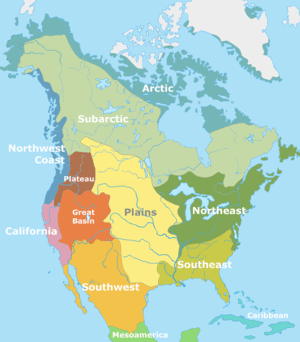
Though cultural features, language, clothing, and customs vary enormously from one tribe to another, there are certain elements which are encountered frequently and shared by many tribes. Early European American scholars described the Native Americans as having a society dominated by clans.[2]
European colonization of the Americas had a major impact on Native American culture through what is known as the Columbian exchange. The Columbian exchange, also known as the Columbian interchange, was the widespread transfer of plants, animals, culture, human populations, technology, and ideas between the Americas and the Old World in the 15th and 16th centuries, following Christopher Columbus's 1492 voyage.[3] The Columbian exchange generally had a destructive impact on Native American culture through disease, and a 'clash of cultures',[4] whereby European values of private property, the family, and labor led to conflict, appropriation of traditional communal lands and slavery.[5]
The impact of the Columbian exchange was not entirely negative however. For example, the re-introduction of the horse to North America allowed the Plains Indian to revolutionize their way of life by making hunting, trading, and warfare far more effective, and to greatly improve their ability to transport possessions and move their settlements.[6]
In the early years, as these native peoples encountered European explorers and settlers and engaged in trade, they exchanged food, crafts, and furs for blankets, iron and steel implements, horses, trinkets, firearms, and alcoholic beverages. Today, while remaining faithful to their traditions, Native American cultures continue to evolve and adapt to changing circumstances.
Cultural areas
Native Americans in the United States fall into a number of distinct ethno-linguistic and territorial phyla, whose only uniting characteristic is that they were in a stage of either Mesolithic (hunter-gatherer) or Neolithic (subsistence farming) culture at the time of European contact.
They can be classified as belonging to a number of large cultural areas:
- Continental U.S.
- Californian tribes (Northern): Yok-Utian, Pacific Coast Athabaskan, Coast Miwok, Yurok, Palaihnihan, Chumashan, Uto-Aztecan
- Plateau tribes: Interior Salish, Plateau Penutian
- Great Basin tribes: Uto-Aztecan
- Pacific Northwest Coast: Pacific Coast Athabaskan, Coast Salish
- Southwestern tribes: Uto-Aztecan, Yuman, Southern Athabaskan
- Plains Indians: Siouan, Plains Algonquian, Southern Athabaskan
- Northeastern Woodlands tribes: Pequot, Mohican, Mohawk, Iroquoian, Central Algonquian, Eastern Algonquian
- Southeastern Woodlands tribes: Muskogean, Siouan, Catawban, Iroquoian,
- Alaska Natives
- Arctic: Eskimo–Aleut
- Subarctic: Northern Athabaskan
- Hawaiians
Language
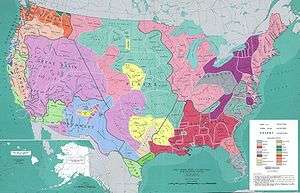
There are approximately 296 spoken (or formerly spoken) indigenous languages north of Mexico, 269 of which are grouped into 29 families.
The major ethno-linguistic phyla are:
- Na-Dene languages,
- Iroquoian languages,
- Caddoan languages
- Algonquian languages
- Algic languages,
- Siouan–Catawban languages,
- Uto-Aztecan languages,
- Salishan languages,
- Tanoan languages
- Eskimo–Aleut (Alaska)
The Na-Dené, Algic, and Uto-Aztecan families are the largest in terms of number of languages. Uto-Aztecan has the most speakers (1.95 million) if the languages in Mexico are considered (mostly due to 1.5 million speakers of Nahuatl); Na-Dené comes in second with approximately 200,000 speakers (nearly 180,000 of these are speakers of Navajo), and Algic in third with about 180,000 speakers (mainly Cree and Ojibwe). Na-Dené and Algic have the widest geographic distributions: Algic currently spans from northeastern Canada across much of the continent down to northeastern Mexico (due to later migrations of the Kickapoo) with two outliers in California (Yurok and Wiyot). The remaining 27 languages are either isolates or unclassified), such as Penutian languages, Hokan, Gulf languages and others.
Organization
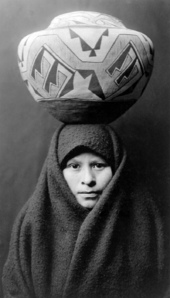
Gens structure
Early European American scholar described the Native Americans (as well as any other tribal society) as having a society dominated by clans or gentes (in the Roman model) before tribes were formed. There were some common characteristics:
- The right to elect its sacheem and chiefs.
- The right to depose its sachem and chiefs.
- The obligation not to marry in the gens.
- Mutual rights of inheritance of the property of deceased members.
- Reciprocal obligations of help, defense, and redress of injuries.
- The right to bestow names on its members.
- The right to adopt strangers into the gens.
- Common religious rights, query.
- A common burial place.
- A council of the gens.[2]
Tribal structure
Subdivision and differentiation took place between various groups. Some functions and attributes of tribes are:
- The possession of the gentes.
- The right to depose these sachems and chiefs.
- The possession of a religious faith and worship.
- A supreme government consisting of a council of chiefs.
- A head-chief of the tribe in some instances.[2]
Traditional diet
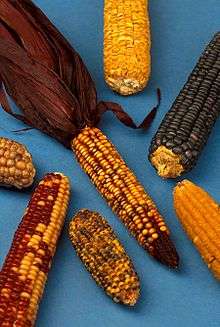
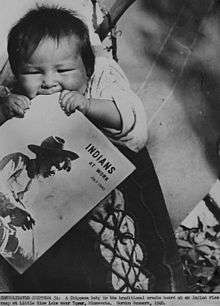
The traditional diet of Native Americans derived from a mixture of agriculture, hunting, and the gathering of wild foods. By 800 CE the Native Americans had established three main crops — beans, squash, and maize (or corn);— called the three sisters. Other early crops included cotton, sunflower, pumpkins, tobacco, goosefoot, knotgrass, and sump weed.
Agriculture in the southwest started around 4,000 years ago when traders brought cultigens from Mexico. Due to the varying climate, some ingenuity was needed for agriculture to be successful. The climate in the southwest ranged from cool, moist mountains regions, to dry, sandy soil in the desert. Some innovations of the time included irrigation to bring water into the dry regions and the selection of seed based on the traits of the growing plants that bore them. In the southwest, they grew beans that were self-supported, much like the way they are grown today.
In the east, however, they were planted right by corn in order for the vines to be able to "climb" the cornstalks. The most important crop the Native Americans raised was maize. It was first started in Mesoamerica and spread north. About 2,000 years ago it reached eastern America. This crop was important to the Native Americans because it was part of their everyday diet; it could be stored in underground pits during the winter, and no part of it was wasted. The husk was made into art crafts, and the cob was used as fuel for fires.
The agriculture gender roles of the Native Americans varied from region to region. In the southwest area, men prepared the soil with hoes. The women were in charge of planting, weeding, and harvesting the crops. In most other regions, the women were in charge of doing everything, including clearing the land. Clearing the land was an immense chore since the Native Americans rotated fields frequently. There is a tradition that Squanto showed the Pilgrims in New England how to put fish in fields to act like a fertilizer, but the truth of this story is debated.
Native Americans did plant beans next to corn; the beans would replace the nitrogen which the corn took from the ground, as well as using corn stalks for support for climbing. Native Americans used controlled fires to burn weeds and clear fields; this would put nutrients back into the ground. If this did not work, they would simply abandon the field to let it be fallow, and find a new spot for cultivation.
Europeans in the eastern part of the continent observed that Natives cleared large areas for cropland. Their fields in New England sometimes covered hundreds of acres. Colonists in Virginia noted thousands of acres under cultivation by Native Americans.[7]
Native Americans commonly used tools such as the hoe, maul, and dibber. The hoe was the main tool used to till the land and prepare it for planting; then it was used for weeding. The first versions were made out of wood and stone. When the settlers brought iron, Native Americans switched to iron hoes and hatchets. The dibber was a digging stick, used to plant the seed. Once the plants were harvested, women prepared the produce for eating. They used the maul to grind the corn into mash. It was cooked and eaten that way or baked as corn bread.[8]
Iñupiat, the Inuit of Alaska, prepared and buried large amounts of dried meat and fish. Pacific Northwest tribes crafted seafaring dugouts 40–50 feet (12–15 m) long for fishing. Farmers in the Eastern Woodlands tended fields of maize with hoes and digging sticks, while their neighbors in the Southeast grew tobacco as well as food crops. On the Plains, some tribes engaged in agriculture but also planned buffalo hunts in which herds were driven over bluffs.
Dwellers of the Southwest deserts hunted small animals and gathered acorns to grind into flour with which they baked wafer-thin bread on top of heated stones. Some groups on the region's mesas developed irrigation techniques, and filled storehouses with grain as protection against the area's frequent droughts.
Religion
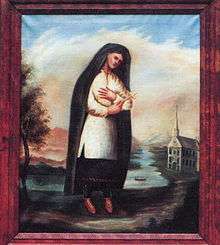

Traditional Native American ceremonies are still practiced by many tribes and bands, and the older theological belief systems are still held by many of the "traditional" people. These spiritualities may accompany adherence to another faith, or can represent a person's primary religious identity. While much Native American spiritualism exists in a tribal-cultural continuum, and as such cannot be easily separated from tribal identity itself, certain other more clearly defined movements have arisen among "traditional" Native American practitioners, these being identifiable as "religions" in the prototypical sense familiar in the industrialized Western world.
Traditional practices of some tribes include the use of sacred herbs such as tobacco, sweetgrass or sage. Many Plains tribes have sweatlodge ceremonies, though the specifics of the ceremony vary among tribes. Fasting, singing and prayer in the ancient languages of their people, and sometimes drumming are also common.
The Midewiwin Lodge is a traditional medicine society inspired by the oral traditions and prophesies of the Ojibwa (Chippewa) and related tribes.
Another significant religious body among Native peoples is known as the Native American Church. It is a syncretistic church incorporating elements of Native spiritual practice from a number of different tribes as well as symbolic elements from Christianity. Its main rite is the peyote ceremony. Prior to 1890, traditional religious beliefs included Wakan Tanka. In the American Southwest, especially New Mexico, a syncretism between the Catholicism brought by Spanish missionaries and the native religion is common; the religious drums, chants, and dances of the Pueblo people are regularly part of Masses at Santa Fe's Saint Francis Cathedral.[9] Native American-Catholic syncretism is also found elsewhere in the United States. (e.g., the National Kateri Tekakwitha Shrine in Fonda, New York and the National Shrine of the North American Martyrs in Auriesville, New York).
The eagle feather law (Title 50 Part 22 of the Code of Federal Regulations) stipulates that only individuals of certifiable Native American ancestry enrolled in a federally recognized tribe are legally authorized to obtain eagle feathers for religious or spiritual use. The law does not allow Native Americans to give eagle feathers to non-Native Americans.
Gender roles

Gender roles were differentiated in most Native American tribes. Both sexes had power in decision making within the tribe. Many tribes, such as the Haudenosaunee Five Nations and the Southeast Muskogean tribes, had matrilineal systems, in which property and hereditary leadership were controlled by and passed through the maternal lines. The children were considered to belong to the mother's clan and achieved status within it. When the tribe adopted war captives, the children became part of their mother's clan and accepted in the tribe. In Cherokee and other matrilineal cultures, wives owned the family property. When young women married, their husbands joined them in their mother's household. This enabled the young women to have assistance for childbirth and rearing; it also protected her in case of conflicts between the couple. If they separated or the man was killed at war, the woman had her family to assist her. In addition, in matrilineal culture, the mother's brother was the leading male figure in a male child's life, as he mentored the child within the mother's clan. The husband had no standing in his wife's and children's clan, as he belonged to his own mother's clan. Hereditary clan chief positions passed through the mother's line. Chiefs were selected on recommendation of women elders, who also could disapprove of a chief. There were sometimes hereditary roles for men called peace chiefs, but war chiefs were selected based on proven prowess in battle. Men usually had the roles of hunting, waging war, and negotiating with other tribes, including the Europeans after their arrival.
Others were patriarchal, although several different systems were in use. In the patrilineal tribes, such as the Omaha, Osage and Ponca, hereditary leadership passed through the male line, and children were considered to belong to the father and his clan. For this reason, when Europeans or American men took wives from such tribes, their children were considered "white" like their fathers, or "half-breeds". Generally such children could have no official place in the tribe because their fathers did not belong to it, unless they were adopted by a male and made part of his family.[10]
Men hunted, traded and made war. The women had primary responsibility for the survival and welfare of the families (and future of the tribe); they gathered and cultivated plants, used plants and herbs to treat illnesses, cared for the young and the elderly, made all the clothing and instruments, and processed and cured meat and skins from the game. They tanned hides to make clothing as well as bags, saddle cloths, and tepee covers. Mothers used cradleboards to carry an infant while working or traveling.[11]
At least several dozen tribes allowed polygyny to sisters, with procedural and economic limits.[2]
Apart from making homes, women had many additional tasks that were also essential for the survival of the tribes. They made weapons and tools, took care of the roofs of their homes and often helped their men hunt bison.[12] In some of the Plains Indian tribes, medicine women gathered herbs and cured the ill.[13]
The Lakota, Dakota, and Nakota girls were encouraged to learn to ride, hunt and fight.[14] Though fighting was mostly left to the boys and men, occasionally women fought with them, especially if the tribe was severely threatened.[15]
Sports

Native American leisure time led to competitive individual and team sports. Jim Thorpe, Joe Hipp, Notah Begay III, Jacoby Ellsbury, and Billy Mills are well known professional athletes.
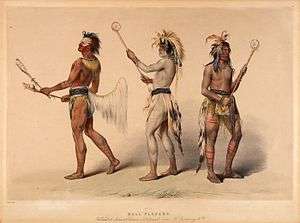
Team based
Native American ball sports, sometimes referred to as lacrosse, stickball, or baggataway, was often used to settle disputes, rather than going to war, as a civil way to settle potential conflict. The Choctaw called it isitoboli ("Little Brother of War");[16] the Onondaga name was dehuntshigwa'es ("men hit a rounded object"). There are three basic versions, classified as Great Lakes, Iroquoian, and Southern.[17]
The game is played with one or two rackets/sticks and one ball. The object of the game is to land the ball on the opposing team's goal (either a single post or net) to score and to prevent the opposing team from scoring on your goal. The game involves as few as 20 or as many as 300 players with no height or weight restrictions and no protective gear. The goals could be from around 200 feet (61 m) apart to about 2 miles (3.2 km); in Lacrosse the field is 110 yards (100 m).
Individual
Chunkey was a game that consisted of a disk shaped stone that was about 1–2 inches in diameter. The disk was thrown down a 200-foot (61 m) corridor so that it could roll past the players at great speed. The disk would roll down the corridor, and players would throw wooden shafts at the moving disk. The object of the game was to strike the disk or prevent your opponents from hitting it.
Music
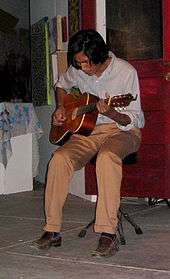
Traditional Native American music is almost entirely monophonic, but there are notable exceptions. Native American music often includes drumming and/or the playing of rattles or other percussion instruments but little other instrumentation. Flutes and whistles made of wood, cane, or bone are also played, generally by individuals, but in former times also by large ensembles (as noted by Spanish conquistador de Soto). The tuning of modern flutes is typically pentatonic.
Performers with Native American parentage have occasionally appeared in American popular music, such as Robbie Robertson (The Band), Rita Coolidge, Wayne Newton, Gene Clark, Buffy Sainte-Marie, Blackfoot, Tori Amos, Redbone, and CocoRosie. Some, such as John Trudell, have used music to comment on life in Native America, and others, such as R. Carlos Nakai integrate traditional sounds with modern sounds in instrumental recordings, whereas the music by artist Charles Littleleaf is derived from ancestral heritage and nature. A variety of small and medium-sized recording companies offer an abundance of recent music by Native American performers young and old, ranging from pow-wow drum music to hard-driving rock-and-roll and rap.
The most widely practiced public musical form among Native Americans in the United States is that of the pow-wow. At pow-wows, such as the annual Gathering of Nations in Albuquerque, New Mexico, members of drum groups sit in a circle around a large drum. Drum groups play in unison while they sing in a native language and dancers in colorful regalia dance clockwise around the drum groups in the center. Familiar pow-wow songs include honor songs, intertribal songs, crow-hops, sneak-up songs, grass-dances, two-steps, welcome songs, going-home songs, and war songs. Most indigenous communities in the United States also maintain traditional songs and ceremonies, some of which are shared and practiced exclusively within the community.[18]
Art
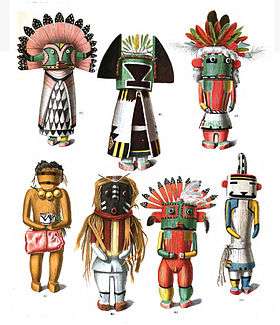
Pueblo peoples crafted impressive items associated with their religious ceremonies. Kachina dancers wore elaborately painted and decorated masks as they ritually impersonated various ancestral spirits. Sculpture was not highly developed, but carved stone and wood fetishes were made for religious use. Superior weaving, embroidered decorations, and rich dyes characterized the textile arts. Both turquoise and shell jewelry were created, as were high-quality pottery and formalized pictorial arts.
Navajo spirituality focused on the maintenance of a harmonious relationship with the spirit world, often achieved by ceremonial acts, usually incorporating sandpainting. The colors—made from sand, charcoal, cornmeal, and pollen—depicted specific spirits. These vivid, intricate, and colorful sand creations were erased at the end of the ceremony. The Eastern Woodland Indians used the hoe.
Native American art comprises a major category in the world art collection. Native American contributions include pottery, paintings, jewelry, weavings, sculpture, basketry, and carvings. Franklin Grits was a Cherokee artist who taught students from many tribes at Haskell Institute (now Haskell Indian Nations University) in the 1940s, the Golden Age of Native American painters. The integrity of certain Native American artworks is protected by an act of Congress that prohibits representation of art as Native American when it is not the product of an enrolled Native American artist.
Writing and communication
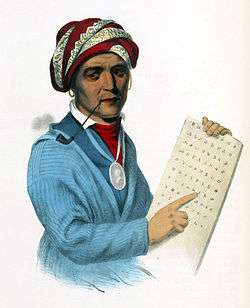
Native Americans in the United States have developed several original systems of communication, both in Pre-Columbian times, and later as a response to European influences. For example, the Iroquois, living around the Great Lakes and extending east and north, used strings or belts called wampum that served a dual function: the knots and beaded designs mnemonically chronicled tribal stories and legends, and further served as a medium of exchange and a unit of measure. The keepers of the articles were seen as tribal dignitaries.[19] Another form of communication was the Wiigwaasabak, birch bark scrolls on which the Ojibwa (Anishinaabe) people wrote complex geometrical patterns and shapes, can also be considered a form of writing.
A widely used form of communication was Plains Indian Sign Language (PISL), also known as Plains Sign Talk,[20] Plains Sign Language and First Nation Sign Language. PISL is a trade language (or international auxiliary language), formerly a trade pidgin, that was once the lingua franca across central Canada, central and western United States and northern Mexico, used among the various Plains Nations. It was also used for story-telling, oratory, various ceremonies, and by deaf people for ordinary daily use.[21]
In the late 1810s and early 1820s, the Cherokee syllabary was invented by the silversmith Sequoyah to write the Cherokee language. His creation of the syllabary is particularly noteworthy as he could not previously read any script.[22] He first experimented with logograms, before developing his system into a syllabary. In his system, each symbol represents a syllable rather than a single phoneme; the 85 (originally 86)[23] characters provide a suitable method to write Cherokee. Although some symbols resemble Latin, Greek, and Cyrillic letters, the relationship between symbols and sounds is different.
The success of the Cherokee syllabary inspired James Evans, a missionary in what is now Manitoba, during the 1840s to develop Cree syllabics. Evans had originally adapted the Latin script to Ojibwe (see Evans system), but after learning of the Cherokee syllabary, he experimented with invented scripts based on his familiarity with shorthand and Devanagari.[24] When Evans later worked with the closely related Cree, and ran into trouble with the Latin alphabet, he turned to his Ojibwe project and in 1840 adapted it to the Cree language.[25] The result contained just nine glyph shapes, each of which stood for a syllable with the vowels determined by the orientations of these shapes. Cree syllabics are primarily a Canadian phenomenon, but are used occasionally in the United States by communities that straddle the border.
Interracial relations
Interracial relations between Native Americans, Europeans, and Africans is a complex issue that has been mostly neglected with "few in-depth studies on interracial relationships".[26][27] Some of the first documented cases of European/Native American intermarriage and contact were recorded in Post-Columbian Mexico. One case is that of Gonzalo Guerrero, a European from Spain, who was shipwrecked along the Yucatan Peninsula, and fathered three Mestizo children with a Mayan noblewoman. Another is the case of Hernán Cortés and his mistress La Malinche, who gave birth to another of the first multi-racial people in the Americas.[28]
Assimilation
European impact was immediate, widespread, and profound—more than any other race that had contact with Native Americans during the early years of colonization and nationhood. Europeans living among Native Americans were often called "White Indians". They "lived in native communities for years, learned native languages fluently, attended native councils, and often fought alongside their native companions."[29]
Early contact was often charged with tension and emotion, but also had moments of friendship, cooperation, and intimacy.[30] Marriages took place in English, Spanish, and French colonies between Native Americans and Europeans. Given the preponderance of men among the colonists in the early years, generally European men married American Indian women.
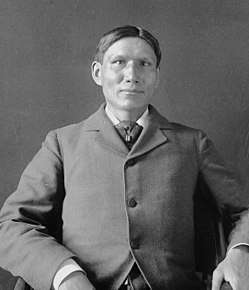
There was fear on both sides, as the different peoples realized how different their societies were.[30] The whites regarded the Indians as "savage" because they were not Christian. They were suspicious of cultures which they did not understand.[30] The Native American author, Andrew J. Blackbird, wrote in his History of the Ottawa and Chippewa Indians of Michigan, (1897), that white settlers introduced some immoralities into Native American tribes. Many Indians suffered because the Europeans introduced alcohol and the whiskey trade resulted in alcoholism among the people, who were alcohol-intolerant.[30]
As European-American women started working independently at missions and Indian schools in the western states, there were more opportunities for their meeting and developing relationships with Native American men. For instance, Charles Eastman, a man of European and Lakota descent whose father sent both his sons to Dartmouth College, got his medical degree at Boston University and returned to the West to practice. He married Elaine Goodale, whom he met in South Dakota. He was the grandson of Seth Eastman, a military officer from Maine, and a chief's daughter. Goodale was a young European-American teacher from Massachusetts and a reformer, who was appointed as the US superintendent of Native American education for the reservations in the Dakota Territory. They had six children together.
Slavery
The majority of Native American tribes did practice some form of slavery before the European introduction of African slavery into North America, but none exploited slave labor on a large scale. In addition, Native Americans did not buy and sell captives in the pre-colonial era, although they sometimes exchanged enslaved individuals with other tribes in peace gestures or in exchange for their own members.[33]
The conditions of enslaved Native Americans varied among the tribes. In many cases, young enslaved captives were adopted into the tribes to replace warriors killed during warfare or by disease. Other tribes practiced debt slavery or imposed slavery on tribal members who had committed crimes; but, this status was only temporary as the enslaved worked off their obligations to the tribal society.[33]
Among some Pacific Northwest tribes, about a quarter of the population were slaves.[34] Other slave-owning tribes of North America were, for example, Comanche of Texas, Creek of Georgia, the Pawnee, and Klamath.[35]
European enslavement
When Europeans arrived as colonists in North America, Native Americans changed their practice of slavery dramatically. Native Americans began selling war captives to whites rather than integrating them into their own societies as they had done before. As the demand for labor in the West Indies grew with the cultivation of sugar cane, Europeans enslaved Native Americans for the Thirteen Colonies, and some were exported to the "sugar islands." The British settlers, especially those in the southern colonies, purchased or captured Native Americans to use as forced labor in cultivating tobacco, rice, and indigo. Accurate records of the numbers enslaved do not exist. Scholars estimate tens of thousands of Native Americans may have been enslaved by the Europeans, being sold by Native Americans themselves.
Slavery became a caste of people who were foreign to the English (Native Americans, Africans and their descendants) and non-Christians. The Virginia General Assembly defined some terms of slavery in 1705:
All servants imported and brought into the Country... who were not Christians in their native Country... shall be accounted and be slaves. All Negro, mulatto and Indian slaves within this dominion ... shall be held to be real estate. If any slave resists his master ... correcting such slave, and shall happen to be killed in such correction ... the master shall be free of all punishment ... as if such accident never happened.
— Virginia General Assembly declaration, 1705[36]
The slave trade of Native Americans lasted only until around 1730. It gave rise to a series of devastating wars among the tribes, including the Yamasee War. The Indian Wars of the early 18th century, combined with the increasing importation of African slaves, effectively ended the Native American slave trade by 1750. Colonists found that Native American slaves could easily escape, as they knew the country. The wars cost the lives of numerous colonial slave traders and disrupted their early societies. The remaining Native American groups banded together to face the Europeans from a position of strength. Many surviving Native American peoples of the southeast strengthened their loose coalitions of language groups and joined confederacies such as the Choctaw, the Creek, and the Catawba for protection.
Native American women were at risk for rape whether they were enslaved or not; during the early colonial years, settlers were disproportionately male. They turned to Native women for sexual relationships.[37] Both Native American and African enslaved women suffered rape and sexual harassment by male slaveholders and other white men.[37]
_of_Lillian_Gross%2C_Niece_of_Susan_Sanders_(Mixed_Blood)_1906.jpg)
Relation with African Americans
African and Native Americans have interacted for centuries. The earliest record of Native American and African contact occurred in April 1502, when Spanish colonists transported the first Africans to Hispaniola to serve as slaves.[38]
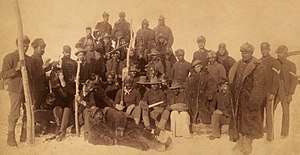
}}</ref> Native Americans were rewarded if they returned escaped slaves, and African Americans were rewarded for fighting in the late 19th-century Indian Wars.[39][40][41]
"Native Americans, during the transitional period of Africans becoming the primary race enslaved, were enslaved at the same time and shared a common experience of enslavement. They worked together, lived together in communal quarters, produced collective recipes for food, shared herbal remedies, myths and legends, and in the end they intermarried."[42] Because of a shortage of men due to warfare, many tribes encouraged marriage between the two groups, to create stronger, healthier children from the unions.[43]
While numerous tribes used captive enemies as servants and slaves, they also often adopted younger captives into their tribes to replace members who had died. In the Southeast, a few Native American tribes began to adopt a slavery system similar to that of the American colonists, buying African American slaves, especially the Cherokee, Choctaw, and Creek. Though less than 3% of Native Americans owned slaves, divisions grew among the Native Americans over slavery.[44] Among the Cherokee, records show that slave holders in the tribe were largely the children of European men that had shown their children the economics of slavery.[40] As European colonists took slaves into frontier areas, there were more opportunities for relationships between African and Native American peoples.[39]
Among the Five Civilized Tribes, mixed-race slaveholders were generally part of an elite hierarchy, often based on their mothers' clan status, as the societies had matrilineal systems. As did Benjamin Hawkins, European fur traders and colonial officials tended to marry high-status women, in strategic alliances seen to benefit both sides. The Choctaw, Creek and Cherokee believed they benefited from stronger alliances with the traders and their societies. The women's sons gained their status from their mother's families; they were part of hereditary leadership lines who exercised power and accumulated personal wealth in their changing Native American societies. The historian Greg O'Brien calls them the Creole generation to show that they were part of a changing society. The chiefs of the tribes believed that some of the new generation of mixed-race, bilingual chiefs would lead their people into the future and be better able to adapt to new conditions influenced by European Americans.
Philosophy
Native American authors have written about aspects of "tribal philosophy" as opposed to the modern or Western worldview. Thus, Yankton Dakota author Vine Deloria Jr. in an essay "Philosophy and the Tribal Peoples" argued that whereas a "traditional Westerner" might reason, "Man is mortal; Socrates is a man; therefore, Socrates is mortal," aboriginal thinking might read, 'Socrates is mortal, because I once met Socrates and he is a man like me, and I am mortal.'[45] Deloria explains that both of the statements assume that all men are mortal, and that these statements are not verifiable on these grounds. The line of Indian thinking, however uses empirical evidence through memory to verify that Socrates was in fact a man like the person originally making the statement, and enhances the validity of the thinking. Deloria made the distinction, "whereas the Western syllogism simply introduces a doctrine using general concepts and depends on faith in the chain of reasoning for its verification, the Indian statement would stand by itself without faith and belief."[46] Deloria also comments that Native American thinking is very specific (in the way described above) compared to the broadness of traditional Western thinking, which leads to different interpretations of basic principles. American thinkers have previously denounced Native ideas because of this narrower approach, as it leads to 'blurry' distinctions between the 'real' and the 'internal.'[47]
According to Carlin Romano, the best resource on a characteristically "Native American Philosophy" is Scott Pratt's, Native Pragmatism: Rethinking the Roots of American Philosophy, which relates the ideas of many 'American' philosophers like Pierce, James, and Dewey to important concepts in early Native thought.[48] Pratt's publication takes his readers on a journey through American philosophical history from the colonial time period, and via detailed analysis, connects the experimental nature of early American pragmatism to the empirical habit of indigenous Americans. Though Pratt makes these alliances very comprehensible, he also makes clear that the lines between the ideas of Native Americans and American philosophers are complex and historically difficult to trace.[49]
References
- "Native American | History, Art, Culture, & Facts". Encyclopedia Britannica.
- Morgan, Lewis H. (1907). Ancient Society. Chicago: Charles H. Kerr & Company. pp. 70–71, 113. ISBN 0-674-03450-3.
- Nunn, Nathan; Qian, Nancy (2010). "The Columbian Exchange: A History of Disease, Food, and Ideas". Journal of Economic Perspectives. 24 (2): 163–188. CiteSeerX 10.1.1.232.9242. doi:10.1257/jep.24.2.163. JSTOR 25703506.
- Emmer, Pieter. "The Myth of Early Globalization: The Atlantic Economy, 1500–1800." European Review 11, no. 1. Feb. 2003. p. 45–46
- Emmer, Pieter. "The Myth of Early Globalization: The Atlantic Economy, 1500–1800." European Review 11, no. 1. Feb. 2003. p. 46
- "Encyclopedia of the Great Plains | HORSE". plainshumanities.unl.edu.
- Krech III, Shepard (1999). The ecological Indian: myth and history (1 ed.). New York, New York: W. W. Norton & Company, Inc. p. 107. ISBN 0-393-04755-5.
- "American Indian Agriculture". Answers.com. Retrieved February 8, 2008.
- A Brief History of the Native American Church Archived August 21, 2007, at the Wayback Machine by Jay Fikes. Retrieved 2006-02-22.
- Melvin Randolph Gilmore, "The True Logan Fontenelle", Publications of the Nebraska State Historical Society, Vol. 19, edited by Albert Watkins, Nebraska State Historical Society, 1919, p. 64, at GenNet, accessed 2011-08-25
- Beatrice Medicine, "Gender", Encyclopedia of North American Indians, February 9, 2006.
- "Native American Women", Indians.org. Retrieved 2007-01-11.
- "Medicine Women" "Archived copy". Archived from the original on June 18, 2012. Retrieved April 15, 2013.CS1 maint: archived copy as title (link), Bluecloud.org. Retrieved 2007-01-11.
- Zinn, Howard (2005). A People's History of the United States: 1492–present, Harper Perennial Modern Classics. ISBN 0-06-083865-5.
- "Women in Battle" "Archived copy". Archived from the original on June 18, 2012. Retrieved April 15, 2013.CS1 maint: archived copy as title (link), Bluecloud.org. Retrieved 2007-01-11.
- "Choctaw Indians". 2006. Retrieved May 2, 2008.
- Thomas Vennum Jr., author of American Indian Lacrosse: Little Brother of War (2002–2005). "History of Native American Lacrossee". Archived from the original on April 11, 2009. Retrieved September 11, 2008.
- Bierhosrt, John (1992). A Cry from the Earth: Music of North American Indians. Ancient City Press.
- Iroquois History. Retrieved 2006-02-23.
- Darin Flynn. "Canadian Languages". University of Calgary. Retrieved August 8, 2015.
- McKay-Cody, Melanie Raylene (1998), "Plains Indian Sign Language: A comparative study of alternative and primary signers", in Carroll, Cathryn (ed.), Deaf Studies V: Toward 2000--Unity and Diversity, Washington DC: Gallaudet University Press, ISBN 1893891097
- Diamond, Jared (1999). Guns, Germs, and Steel: The Fates of Human Societies. New York, New York: Norton. p. 228. ISBN 0393317552.
- Sturtevant & Fogelson 2004, p. 337.
- ["Plains Cree History". Archived from the original on August 17, 2018. Retrieved August 29, 2018.
- Campbell, George (1991). Compendium of the World's Languages, 2nd ed. pp. 422–428.
- Mary A. Dempsey (1996). "The Indian connection". American Visions. Archived from the original on June 9, 2005. Retrieved September 19, 2008.
- Katherine Ellinghaus (2006). Taking assimilation to heart. U of Nebraska Press. p. 176. ISBN 978-0-8032-1829-1.
- "Sexuality and the Invasion of America: 1492–1806". Archived from the original on October 23, 1997. Retrieved May 19, 2009.
- "Sharing Choctaw History". A First Nations Perspective, Galafilm. Archived from the original on December 26, 2007. Retrieved February 5, 2008.
- "Native Americans: Early Contact". Students on Site. Archived from the original on May 10, 2008. Retrieved May 19, 2009.
- "Indian Achievement Award". Ipl.org. Archived from the original on July 3, 2010. Retrieved August 22, 2010.
- "Charles A. Eastman". Answers.com. Retrieved August 22, 2010.
- Tony Seybert (2009). "Slavery and Native Americans in British North America and the United States: 1600 to 1865" (PDF). Retrieved June 20, 2009.
- "Slavery in Historical Perspective Archived 2012-06-14 at the Wayback Machine". Digital History, University of Houston.
- "Slave-owning societies". Encyclopædia Britannica's Guide to Black History.
- "The Terrible Transformation:From Indentured Servitude to Racial Slavery". PBS. 2009. Retrieved January 7, 2010.
- Gloria J. Browne-Marshall (2009). ""The Realities of Enslaved Female Africans in America", excerpted from Failing Our Black Children: Statutory Rape Laws, Moral Reform and the Hypocrisy of Denial". University of Daytona. Retrieved June 20, 2009.
- Muslims in American History : A Forgotten Legacy by Dr. Jerald F. Dirks. ISBN 1-59008-044-0 p. 204.
- Dorothy A. Mays (2008). Women in early America. ABC-CLIO. ISBN 978-1-85109-429-5. Retrieved May 29, 2008.
- Art T. Burton (1996). "CHEROKEE SLAVE REVOLT OF 1842". LWF COMMUNICATIONS. Archived from the original on September 29, 2009. Retrieved May 29, 2009.
- Fay A. Yarbrough (2007). Race and the Cherokee Nation. Univ of Pennsylvania Press. ISBN 978-0-8122-4056-6. Retrieved May 30, 2009.
- National Park Service (May 30, 2009). "African American Heritage and Ethnography: Work, Marriage, Christianity". National Park Service.
- Nomad Winterhawk (1997). "Black Indians want a place in history". Djembe Magazine. Archived from the original on July 14, 2009. Retrieved May 29, 2009.
- William Loren Katz (2008). "Africans and Indians: Only in America". William Loren Katz. Archived from the original on May 13, 2008. Retrieved May 6, 2009.
- Romano, Carlin. America the Philosophical. New York: Random House Inc., 2012. 446. Print.
- Waters, Anne. American Indian Thought. Malden, MA: Blackwell Publishing Ltd, 2004. 6. Print.
- Waters, Anne. American Indian Thought. Malden, MA: Blackwell Publishing Ltd, 2004. 6-8. Print.
- Romano, Carlin. America the Philosophical. New York: Random House Inc., 2012. 447. Print.
- Pratt, Scott. Native Pragmatism: Rethinking the Roots of American Philosophy. Bloomington: Indiana University Press, 2002. 6-10. Print.
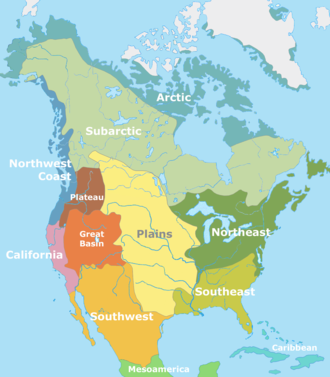
.svg.png)